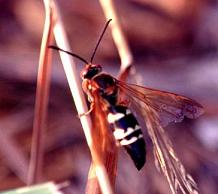 |
Cicada Killer Wasps |
|||||||||||||
|
Get Our Free Newsletter
Home
|
 These
large (1-1/3- to 1-5/8-inches long) wasps can be seen flying slowly above
the surface of the ground. Cicada killers have a black body marked
with yellow across the thorax and abdomen. The wings are reddish
orange. Although these wasps are huge, they usually ignore
people. Males may act aggressively if they feel threatened, but are
unable to sting. Females are able to sting but are so non-aggressive
that they rarely do. Even if they do sting, the pain is much less
than that of smaller wasps such as the yellow jacket or paper wasp.
The cicada killer sting is on par with that of a sweat bee. These
large (1-1/3- to 1-5/8-inches long) wasps can be seen flying slowly above
the surface of the ground. Cicada killers have a black body marked
with yellow across the thorax and abdomen. The wings are reddish
orange. Although these wasps are huge, they usually ignore
people. Males may act aggressively if they feel threatened, but are
unable to sting. Females are able to sting but are so non-aggressive
that they rarely do. Even if they do sting, the pain is much less
than that of smaller wasps such as the yellow jacket or paper wasp.
The cicada killer sting is on par with that of a sweat bee.
Cicada killers are not dangerous and we normally do not recommend control. However, they can be a nuisance. If you believe control is necessary, treat the burrows after dark to ensure the female wasps are in their nests. The males normally roost on plants near the burrow sites. They can be captured with an insect net or knocked out of the air with a tennis racket during the day. Carbaryl (Sevin) or diazinon may be used for control.
Nuisance of the Week is brought to
you in cooperation with the Kansas
State University Research & Extension
|
|||||||||||||
|
© 1999 - 2009 Savvygardener.com, Inc. All rights reserved. If you wish to copy, transmit, or otherwise duplicate any of the material from our website please ask us first. Thank you. |
||||||||||||||
 The cicada killer is
a solitary wasp rather than a social wasp like the yellow jacket.
The female nests in burrows in the ground. These burrows are about
the size of a quarter in diameter and can go 6 inches straight down and
another 6 inches horizontally. Adults normally live 60 to 75 days
from mid July to mid September and feed on flower nectar and sap
exudates.
The cicada killer is
a solitary wasp rather than a social wasp like the yellow jacket.
The female nests in burrows in the ground. These burrows are about
the size of a quarter in diameter and can go 6 inches straight down and
another 6 inches horizontally. Adults normally live 60 to 75 days
from mid July to mid September and feed on flower nectar and sap
exudates.  The adult female
seeks cicadas on the trunks and lower limbs of trees. She then
stings her prey, flips it over, straddles it and carries it to her
burrow. If she has a tree to climb, she will fly with it. If
not, she will drag it. She will lay one egg per cicada and then
stuff them into her burrow. Each burrow normally has three to four
cells with one to two cicadas each. However, it is possible for one
burrow to have 10 to 20 cells. Eggs hatch in 2 to 3 days and larvae
begin to feed on the paralyzed cicadas. Feeding
continues for 4 to 10 days until only the outer shell of the cicada
remains. The larva overwinters inside a silken case it has
spun. Pupation occurs in the spring. There is one generation
per year.
The adult female
seeks cicadas on the trunks and lower limbs of trees. She then
stings her prey, flips it over, straddles it and carries it to her
burrow. If she has a tree to climb, she will fly with it. If
not, she will drag it. She will lay one egg per cicada and then
stuff them into her burrow. Each burrow normally has three to four
cells with one to two cicadas each. However, it is possible for one
burrow to have 10 to 20 cells. Eggs hatch in 2 to 3 days and larvae
begin to feed on the paralyzed cicadas. Feeding
continues for 4 to 10 days until only the outer shell of the cicada
remains. The larva overwinters inside a silken case it has
spun. Pupation occurs in the spring. There is one generation
per year.